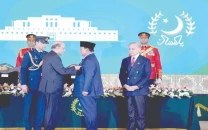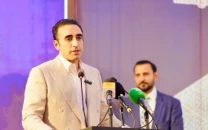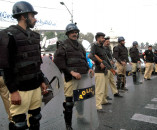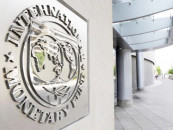Development budget likely to top Rs4tr
Coalition's political priorities dominate as health, education and water see deep cuts

The government is set to approve a record Rs4.1 trillion national development budget for the Centre and provinces amid scarcity of resources that has compelled it to ban small-scale projects and not to include federally-funded province-specific new schemes for next year.
Despite the threat of blocking water by India, the government has proposed to reduce the water sector allocation by 45% or Rs119 billion to just Rs140 billion for the fiscal year 2025-26 against the originally approved budget.
Yet, the proposed federal Public Sector Development Programme (PSDP) reflects the coalition government's political priorities, with hefty allocations for road infrastructure, while funding for education, health, and water has been significantly slashed for the fiscal year 2025-26.
The Annual Plan Coordination Committee (APCC) will today (Monday) approve the national development budget outlays for the federal government, four provincial governments and the special areas of Pakistan.
Planning Minister Ahsan Iqbal will chair the meeting, which will also recommend 4.2% economic growth and 7.5% inflation targets for the next fiscal year.
The federal PSDP has been finalised by a committee constituted by Prime Minister Shehbaz Sharif aimed at accommodating the needs of the coalition partners.
The APCC will approve a cumulative Rs4.1 trillion outlay for development, which will be Rs300 billion or 8% higher than this fiscal year's original budgets approved by the National and four provincial assemblies.
There has been a reduction in the federal PSDP, but the four provincial governments will cumulatively spend 28% higher than this year's budget from their own resources. Provinces are rich, thanks to the ill-planned National Finance Commission award of 2010.
The APCC will approve Rs1 trillion federal PSDP, down by Rs400 billion compared to this fiscal year's original budget approved in June last year. The federal government will borrow Rs270 billion from abroad to fund this Rs1 trillion spending.
The four governments plan to spend Rs2.8 trillion, higher by Rs609 billion or 28% over this year's original budgets. The provincial governments will also borrow Rs802 billion from abroad to fund their projects.
Another Rs288 billion will be spent by the government-owned companies outside the federal budget.
Punjab is on a spending spree, as it plans to spend Rs1.19 trillion, which is higher by Rs346 billion or 41% over this fiscal year's budget.
Khyber-Pakhtunkhwa will follow Punjab with Rs440 billion spending, also higher by 63%.
Sindh government plans to spend Rs887 billion, higher by Rs60 billion or 7%. The Balochistan government is proposing Rs280 billion for development, which is higher by Rs32 billion over the originally approved budget.
No fiscal space
The federal and provincial governments are loosening their purses despite the country facing challenging economic conditions. The federal government, constrained by limited fiscal space, is once again allocating Rs1 trillion, even though it managed to spend only Rs600 billion during the first 11 months of the current fiscal year.
The APCC will approve not to include any new provincial nature project in the PSDP due to fiscal constraints. It will also approve a moratorium on approval of up to Rs1 billion projects till completion of the IMF programme. However, an exception is also being proposed from the moratorium in case of "compelling conditions".
Despite fiscal constraints, projects pertaining to devolved subjects and provincial in nature are still being financed under the federal PSDP. About 30-40% of PSDP goes to the provincial nature projects, which have seriously undermined the progress of mega and core projects of national significance, according to the planning ministry.
The projects of national importance are delayed due to thin spread funding, and around 90% ongoing projects have been revised with cost increase and time overrun, it added.
The APCC may also issue directions that the development funds should not be diverted to non-development purposes during the currency of the fiscal year.
The APCC will review whether projects with high impact, focused on completion within 3-4 years, will be funded. The proposed PSDP gives priority to foreign-funded and core, and high-impact projects.
However, a cursory look at the proposed PSDP suggests that despite tough economic conditions, the government has given importance to politically nature projects by increasing allocations for the National Highway Authority and the provincial nature projects.
The allocation for the provincial projects has been proposed to be increased from Rs19 billion to Rs93.4 billion. Likewise, the NHA budget has been proposed to be increased to a whopping Rs229 billion, up by Rs49 billion or 27%.
To make room for higher spending on political priorities of the coalition partners, the government has proposed to drastically reduce the funding of the water and power sector projects.
The power sector budget is proposed to be reduced by Rs72 billion or 41% to Rs104 billion. The water sector allocation is proposed to be cut by Rs119 billion to just Rs140 billion. Diamer Basha dam project will get Rs35 billion in the next fiscal year compared to Rs40 billion this year, according to the sources.
The federal ministry of education's budget has been proposed to be cut by 27% to Rs20 billion, while the Higher Education Commission's budget is proposed to be reduced by Rs21 billion or 32% to Rs45 billion.
Despite challenges, the government has also retained a Rs50 billion allocation for the parliamentarians' schemes under the umbrella of the Sustainable Development Goals Achievement Programme.
Around 1,071 development projects with a cumulative cost of Rs13.4 trillion are currently under implementation.
They need another Rs10.2 trillion for completion, which the Planning Ministry states would take more than 10 years to complete.
Compared to the original Rs1.4 trillion approved federal PSDP in the budget, the actual spending as of the end of May remained at Rs596 billion, which is hardly 43% of the parliament's approved budget.
The government admits that Pakistan, withan IMF programme, undergoes some limitations and thus the challenge ahead is to leverage the limited resources in a way to achieve maximum returns from each project to satisfy goals and objectives outlined in the national economic transformation plan, the 5Es-based five-year plan and the "Uraan Pakistan Programme" while overcoming challenges.
There are also implementation issues, and during recent reviews, the planning ministry had identified 183 projects, mostly at the DDWP level, as problematic and slow-moving. It has been recommended to cap or close all these projects by June 2025.
By capping or closing such projects, around Rs1 trillion could be saved and fiscal space could be created for fast-moving ongoing projects as well as new high-impact priority projects, according to a proposal to the APCC.

























COMMENTS
Comments are moderated and generally will be posted if they are on-topic and not abusive.
For more information, please see our Comments FAQ